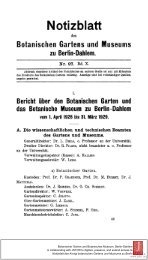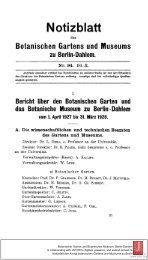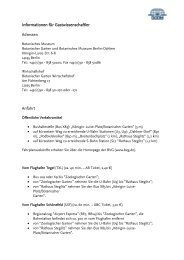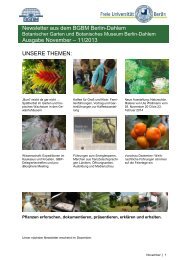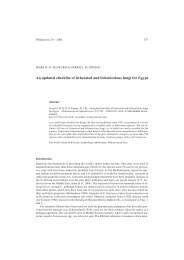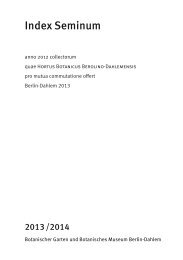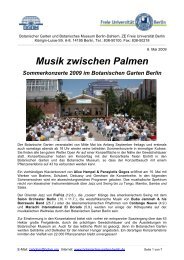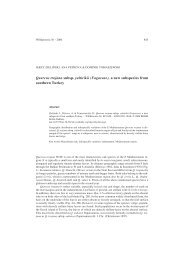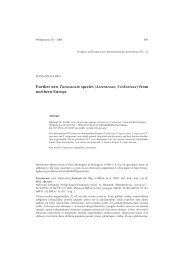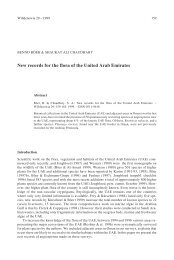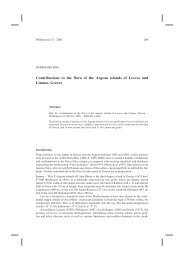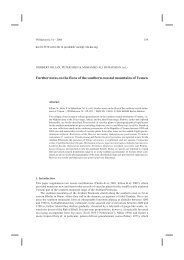The genus Dionysia (Primulaceae), a synopsis and five new species
The genus Dionysia (Primulaceae), a synopsis and five new species
The genus Dionysia (Primulaceae), a synopsis and five new species
Create successful ePaper yourself
Turn your PDF publications into a flip-book with our unique Google optimized e-Paper software.
Willdenowia 37 – 2007 39<br />
<strong>and</strong> an account of Iranian taxa by Jamzad (1996). All in all, Grey-Wilson contributed three <strong>and</strong><br />
Jamzad four <strong>new</strong> <strong>species</strong>.<br />
An evolutionary approach to the classification of <strong>Dionysia</strong> has now been made possible by<br />
the recent molecular studies by Mast & al. (2001) <strong>and</strong> Trift & al. (2004). <strong>The</strong>se authors present a<br />
phylogeny, which in parts differs drastically from the speculative schemes of Melchior (1943)<br />
<strong>and</strong> Wendelbo (1961a), which involved now obsolete concepts like “advancement level”.<br />
Morphology <strong>and</strong> relationships<br />
That <strong>Dionysia</strong>, though surely a natural group in itself, can not be demarcated from Primula has<br />
been obvious from the start. Both Wendelbo (1961a) <strong>and</strong> Grey-Wilson (1989) realised that <strong>Dionysia</strong><br />
belongs in Primula in a genealogical classification, but as both accepted a polyphyletic<br />
Primula, they saw no problems in recognising <strong>Dionysia</strong> as a <strong>genus</strong>, following the tradition of<br />
Bornmüller <strong>and</strong> Melchior.<br />
<strong>Dionysia</strong> differs from most Primula in the base chromosome number 10, the suffruticose<br />
habit, long corolla tube <strong>and</strong> a capsule that splits to the base into 5 valves. Further, several <strong>species</strong><br />
are characterised by woolly farina, which is very rare in Primula (Wendelbo 1961a) but present in<br />
P. qinghaiensis (Trift & al. 2002). Efarinose <strong>species</strong> <strong>and</strong> <strong>species</strong> with powdery farina are also<br />
known in <strong>Dionysia</strong>. All characters distinguishing <strong>Dionysia</strong> can be found in other groups of Primula,<br />
though never in combination, <strong>and</strong> accordingly <strong>Dionysia</strong> can be quite easily circumscribed<br />
<strong>and</strong> its naturalness has been strongly confirmed by molecular evidence, including large unique deletions<br />
in two of the sequenced regions (Trift & al. 2004). Recognising <strong>Dionysia</strong> as a <strong>genus</strong>, however,<br />
makes Primula polyphyletic, since the sister group of <strong>Dionysia</strong> is not Primula, but only a part<br />
of Primula: the sub<strong>genus</strong> Sphondylia (Mast & al. 2001, Trift & al. 2004, Wendelbo 1961a-c).<br />
<strong>The</strong> <strong>species</strong> of Primula subg. Sphondylia are similar to some <strong>species</strong> of <strong>Dionysia</strong> sect. Dionysiopsis<br />
Pax (e.g., D. mira <strong>and</strong> D. bornmuelleri), although the Sphondylia <strong>species</strong> differ in involute<br />
young leaves, 3-furrowed pollen grains <strong>and</strong> a capsule that splits apically into ten teeth. <strong>The</strong><br />
pollen in <strong>Dionysia</strong> usually has 6-8 furrows. Both pollen types are known from Primula s.str.<br />
(Wendelbo 1961c). Wendelbo (1961b) considered the sub<strong>genus</strong> Sphondylia “primitive” in Primula,<br />
but it seems as if at least the peculiar type of conduplicate-involute leaf vernation (Mast &<br />
al. 2001) is a derived character (synapomorphy) for the sub<strong>genus</strong> Sphondylia.<br />
Towards a natural classification of <strong>Dionysia</strong><br />
It can be concluded from character optimization on phylogenetic trees (Mast & al. 2001, Trift &<br />
al. 2002, 2004) that the ancestral <strong>Dionysia</strong> had a lax habit with large dentate revolute leaves,<br />
flowers in a stalked umbel (or in superposed verticils) subtended by foliaceous bracts <strong>and</strong> a yellow,<br />
externally hairy corolla with a long tube – conclusions reached already by Melchior (1943).<br />
Consequently, there is nothing that suggests that the <strong>species</strong> with these characteristics (1-5,<br />
15-18 in the list below) assembled in D. subsect. Scaposae by Wendelbo form a natural group, as<br />
the traits used to circumscribe subsect. Scaposae are all ancestral in <strong>Dionysia</strong>.<br />
Indeed, the molecular results suggest that two “Scaposae” <strong>species</strong>, <strong>Dionysia</strong> hissarica <strong>and</strong><br />
D. balsamea, together form a sister group to the other <strong>Dionysia</strong>. <strong>The</strong> union of these two <strong>species</strong> is<br />
surprising, as it seems to be in conflict with morphological evidence, D. balsamea being superficially<br />
more similar to D. paradoxa. However, the molecular evidence is very clear <strong>and</strong> there are<br />
some morphological characters that distinguish the two from D. paradoxa: comparatively fewseeded<br />
capsules, blunt teeth on the leaves <strong>and</strong> long egl<strong>and</strong>ular hairs.<br />
<strong>The</strong> western <strong>species</strong> (15-18) of subsection Scaposae sensu Wendelbo are better put together<br />
with the similarly western <strong>species</strong> of subsection Revolutae Wendelbo, with which they share<br />
many characters. Although here is no molecular support for this grouping, there is nothing that<br />
contradicts it. <strong>The</strong> valid name for this taxon is D. sect. Dionysiopsis.<br />
<strong>The</strong> second important deviation from previous classifications (Wendelbo 1961, Grey-Wilson<br />
1989) is the reshuffling of the <strong>species</strong> of section <strong>Dionysia</strong> sensu Wendelbo. It is obvious that un-



